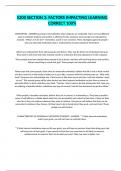5200 SECTION 3: FACTORS IMPACTING LEARNING
CORRECT 100%
MOTIVATION - ANSWER Learning is most effective when students are motivated. There are two different
ways to motivate students and neither is effective for ALL students. Some people are motivated by
rewards. "What's in it for me?" motivation, and it is very common. These strategies appeal to people
who are externally motivated, that is, motivated by rewards outside of themselves.
Others are motivated by their internal goals and desires. They may be driven to sell products because
they want to sell more than they sold last month or to become the best salesperson in the company.
These people may have decided they wanted to be a doctor, and they will work long hours and sacrifice
almost everything to reach that goal. These people are internally motivated.
Rotter says that some people, those who are externally motivated, believe that life is not in their control
and that control is in the hands of others or is up to fate. A person with this mindset may say, "Why work
hard? Someone else will probably win. If the forces of fate want me to win then I will win whether I work
or not." This second group will be slow starters and need external motivation to give them a reason to
put forth effort. In their mind they may think, "Teacher, I don't want to do that homework, BUT since you
are offering a beautiful sticker, (substitute any type of reward) I will do that homework to get the sticker."
Other people, internally motivated, believe they are in control, or reasonably so. They have a positive
sense of self-efficacy, or belief about what they can accomplish and control in their lives. If they set their
mind to it, they can achieve whatever they want to achieve. This person will believe that they can be
successful in whatever they choose. All they have to do is decide what they want, and work hard. These
people are self-starters.
CHARACTERISTICS OF INTERNALLY MOTIVATED STUDENTS - ANSWER ** If their internal motivations
match your goals, you will not have to motivate them.
**If their internal motivation does not fit your goals, you will have to convince them that doing your task
will meet one of their goals. If you cannot do that then you may have to fall back on external
reinforcement to convince them to do what you want. They may want a sticker, too.
, CHARACTERISTICS OF EXTERNALLY MOTIVATED STUDENTS - ANSWER **Motivation is a matter of finding
a reinforcement that they want. Reinforcement might be a tangible reward, a word of praise, or some
other indication that they have achieved.
**Different students will be motivated by different reinforcement. One may do the work for a sticker, but
someone else might want a candy bar. The challenge is to find what will work for each student.
**The other side of reinforcement is punishment. Rather than offering a reward for doing homework
you can threaten a punishment for not doing it. Punishment is not very effective for many students. In
addition, it makes them hate the teacher and school, which is not effective in the end.
You will avoid much wasted time and student frustration by gauging students' readiness early and often.
Even with knowledge of the various learning theories and understanding of motivation acquired in the
previous section, you will face an uphill battle as a teacher if the students in your class are not ready to
learn.
As you review the following factors, you will notice that in order to help students develop greater
readiness, you will need to get to know them. This is tremendously important. Each student in your class
is an individual, with thoughts, feelings, experiences, interests, and challenges unique to him or her.
try to become an expert in the kids in your classroom. You can do this with "Getting to know you"
activities at the beginning of the school year, through formal or informal assessments of their current
knowledge (more on this in the next course), through a review of their prior work or by talking with last
year's teachers
HEALTH AND HOME LIFE - ANSWER A student's personal health and home life are significant factors to
their readiness to learn. If a student does not have enough to eat, hunger pains will drown out their
ability to concentrate on the lesson at hand. Similarly, if a child is experiencing family tension or if the
student's family does not place a high value on education, learning will be hindered.
You cannot control your student's home life, but getting to know your students in a personal way will
help you to account for distractions they may carry into your classroom. Learn more about the resources
at your school, whether free and reduced lunch or a counseling referral, to help minimize the negative
consequences of a difficult home life. Equally important, be compassionate and listen to the specific
concerns and burdens your students may be carrying.




